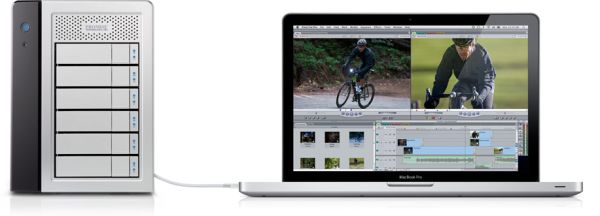MacBook Pro 2011 Refresh: Specs and Details
by Andrew Cunningham on February 24, 2011 4:40 PM ESTThunderbolt
The new MacBook Pros offer the array of ports we're used to, plus something a bit different.
A new port called Thunderbolt replaces the Mini DisplayPort found in earlier models. Formerly codenamed Light Peak, the new Intel standard promises up to 10 Gbps bi-directional data transfer speeds and connectivity for an array of devices, from displays to hard drives. The standard also supports 8-channel audio, which should make for easy connection to HDMI devices with the right adapter, and up to six different Thunderbolt devices can be daisy chained together according to the Intel specs.
Most of the given use scenarios for Thunderbolt focus on external hard drives, displays, and HD video hardware, and adapters for existing standards like eSATA and Firewire. If Thunderbolt ports become more widespread, we'll probably see additional applications of the standard.

Finally, it's worth noting that if you've already spent money on Mini DisplayPort adapters, dongles and cables for your existing Mac, those accessories will continue to work with the new Thunderbolt port.
Look for more from us on Thunderbolt shortly.
Conclusions
Thunderbolt aside, there's not much that surprises about the new MacBook Pro lineup - as usual, new, faster hardware is being sold to us in the same attractive unibody case to which we've become accustomed.
Most of the additions are welcome, though the value proposition continues to be a struggle. As usual, to save money, you're better off buying the base model and adding RAM or a new hard drive yourself than paying Apple's price for upgrades.
The move to Sandy Bridge is interesting but the lack of any mention of Quick Sync is a bit bothersome. We’re working on our review of the new platforms, expect to see results in the coming days.











128 Comments
View All Comments
MrBrownSound - Thursday, February 24, 2011 - link
Is the intel i7 2.0 GHz quad core - so much different than the i7 2.2 GHz quad core?I mean it's a 250 difference, I know it's not a huge amount considering that your already going to spend a cool couple grand, but still.
I'd would love to see some real world benchmarks ANANDTECH! thank you
gc_ - Friday, February 25, 2011 - link
http://ark.intel.com/Compare.aspx?ids=50067,53463,...Guess: higher enterprise demand for the 2.2GHz quad processor (Intel i7-2720QM ) means Intel prices it maybe $200+ more. Its virtual machine, encryption, and security features are not available on 2.0GHz quad processors (Intel i7-2630QM, Intel i7-2635QM).
• Intel® Virtualization Technology for Directed I/O (VT-d)
• AES New Instructions [encryption]
• Intel® Anti-Theft Technology
• Execute Disable Bit
johnspierce - Saturday, February 26, 2011 - link
The $250 is not just for the 2.2 i7 -- it also has a massively better video card in the AMD Radeon HD 6750M with 1GB GDDR5 memory vs. the AMD Radeon HD 6490M with 256MB GDDR5. Also comes with either the 750gb 5400 drive or the 500gb 7200 drive vs. the 500gb 5400 drive in the base model. $250 doesn't sound so bad with those 3 significant upgrades.gc_ - Sunday, February 27, 2011 - link
Actually, looking at Apple's US website today,there is a $250 difference to upgrade from 2.2GHz to 2.3GHz, not 2.0GHz to 2.2GHz.
(The 2.0Ghz version of the MBP15 is not offered with a CPU upgrade, and the difference to the 2.2GHz version of the MBP15 is $400, not $250, with additional features that johnspierce noted.)
Intel's list price is difference is:
US$568 for i7-2820QM (2.3GHz to 3.4GHz, 8MB cache, quantity 1000)
US$378 for i7-2720QM (2.2GHz to 3.3GHz, 6MB cache, quantity 1000)
------------
US$190 difference
Apple's purchase price difference from Intel is likely even greater:
The i7-2720QM is in the Apple standard models
Apple will buy it in much greater quantity than the custom-only i7-2820QM.
Thus, Apple probably gets a much better discount on the i7-2720QM than on the i7-2820QM.
http://ark.intel.com/Compare.aspx?ids=52227,50067,...
store.apple.com
da585 - Thursday, February 24, 2011 - link
Hope Anandtech could give us more detail about the reviews. I have some questions as shown:• SATA 3 or SATA 2?
• Battery life
• Screen Quality…
I feel sad that Apple doesn't shrink the MBP's weights.
KPOM - Friday, February 25, 2011 - link
On MacRumors, some buyers of the new Pro have confirmed it supports SATA 3.seapeople - Friday, February 25, 2011 - link
It either supports SATA 3 or Apple is going to have to replace everyone's motherboard when Intel finally fixes their SB boards.I'm guessing it's SATA 3.
jamesst - Monday, February 28, 2011 - link
A marketing manager/head (apparently fairly high level) said that Apple isn't using the defective Intel Platform Hubs in any of the new MacBooks, so the SATA bug isn't an issue.johnspierce - Saturday, February 26, 2011 - link
+1 on Battery life. Laptopmag already has a review out showing the new MBP has about 40% less battery life compared to last year's model, but CNET's review shows it having about 15% *better* battery life. Which is it?I will only trust the results when Anandtech does the review! :D
TheUsual - Thursday, February 24, 2011 - link
I wish I'd known 9 months ago they would have the quad core sandy bridge in there, I would have held off. All the rumors led me to believe they would stay with dual cores. I'm still paying on my 2.6 dual core MBP. I'm sure it's worth much less now, oh well. It's still a great laptop.